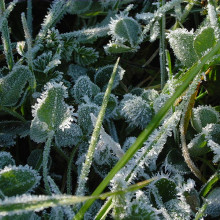Naked Question and Answer and Venomous Vipers
Dr Chris and Dr Helen answer all your burning science questions, including why frost can form even when the air temperature is above zero, why hair looks darker when it is wet, why sunlight looks red through your eyelids, and whether cracking your knuckles really causes arthritis. We also talk to Chemistry World editor Mark Peplow about venomous vipers, artificial kidneys, and how LSD might be switching on hallucinations, and in Kitchen Science Anna Lacey and Dave Ansell look at some slightly safer visual effects with the help of a sodium street light.
In this episode
Ancient Hot Stuff
Are you a fan of hot spicy food? Well it seems that us humans have been enjoying fiery food for a very long time indeed. In fact South Americans may have been spicing up their food with chillies for at least 6 thousand years. That's according to a new study which found miniscule traces of chillies in ancient cookware from Ecuador, a discovery that was something of an accident. For years, archaeologists have been scratching their heads over the identity of ancient grains of starch from South America which were not from any of the known staple food groups known from the region like maize and squash. But a team of scientists lead by Linda Perry from Smithsonian National Museum of Natural History in Washington DC, have discovered that modern cultivated peppers, including chillies, have much larger starch grains that their wild relatives - and so taking another look at these mysterious ancient starch grains the team finally identified them as the fiery chilli pepper. So, we now know what has long been suspected but never proven, that the ancient south Americans were using chillies as a spice long before Christopher Columbus arrived and took chillies back to Europe from where they spread around the rest of the world. And perhaps the strangest thing about the ancient cultivation of chillies is why did people do it in the first place? Taking a bite of wild chilli must have been a blistering experience even for the most macho man, so why did people bother going to the trouble of domesticating them?
AIDS Virus Achillies Heel Discovered
Scientists at the US NIH vaccine research centre may have uncovered HIV's weak spot, offering the promise of a target for a vaccine. Patients with HIV make heaps of antibodies against the virus but they don't seem to neutralise it. Now, in this week's Nature, Peter Kwong has dissected the workings of one rare antibody, B12, which can neutralise the infection. It turns out that the virus alters the shape of the docking station it uses to lock onto cells as it infects, preventing most antibodies from working. Making a stabilised artificial version of this docking protein, in the altered shape, might therefore drive the immune system to produce antibodies capable of blocking the effect.
Deep Sea Flirting
This week we've had another exciting glimpse of what life is like in the unseen deep ocean, from a team of scientists led by Tsunemi Kubodera from the National Science Museum in Tokyo who have taken brand new high definition film of a deep sea squid which seem to be behaving rather strangely a very long way down beneath the waves. The Dana octopus squid grows to over 2 meters long and lives between 300 to 900m down in the ocean. It has large glowing bulbs called photophores on the end of two of its eight legs. The new video footage taken off the Ogasawara Islands, in the western North Pacific, showed the squid using these shining lights when hunting - Maybe the squid was trying to confuse or perhaps stun their prey by blinding them with flashing lights or possibly the squid was using light to measure distance to its prey in the pitch black deep sea environment. The team were also surprised to discover just how swift and agile a predator the dana octopus squid is, because it was previously suspected to be sluggish and slow moving. And an even stranger behaviour was observed when the team switched on two torches attached to the outside of their submersible vessel - it seems that the giant squid may have mistaken them for another squid because it showed great interest in them and even seemed to try and communicate with them, flashing their photophores - so perhaps the huge squid was trying to flirt with its new found squid friend, after all it must be a cold lonely place all that way down beneath the waves. Link to film clips:
http://www.pubs.royalsoc.ac.uk/media/proceedings_b/papers/Video_clip_4.mov

Why sodium street lights make things look orange

- Venomous Vipers, Artificial Kidneys and LSD
Venomous Vipers, Artificial Kidneys and LSD
with Mark Peplow
Chris - Time now to find out about various things, including how toads are having their poison stolen by snakes, how we could be a step closer to making an artificial kidney, and we could possibly be unlocking the secrets of LSD. That's because the editor of Chemistry World, the magazine of the Royal Society of Chemistry, Mark Peplow is with us now. So what's this story about snakes that are robbing toads of their toxins?
Mark - Most animals tend to steer clear of poisonous toads, but scientists have found that there's a species of Japanese snake, the Japanese colubrid snake, that actually seeks out toads because it wants to eat them. This is so it can steal their toxins and use them to kill its prey.
Chris - But why doesn't the snake end up succumbing to the toxin?
Mark - Well that's the interesting thing. Now that the scientists involved have actually found out that it's able to do this, they hope now that they're going to be able to work out why it does this. What they did was analyse two different groups of snake. One of them was fed on these toads and the other one didn't have the toads in its diet. They found that it was only the ones that were able to eat toads that ended up being poisonous.
Chris - So it's not a genetic difference, it's purely a dietary difference.
Mark - That's right. There's a small island off Japan where these snakes don't have access to toads, and they found that if they took snakes from that island and gave them toads, they ultimately became poisonous after a relatively short time. When they looked at exactly what molecules the snake was using, they found that they'd actually changed the molecule slightly. So they'd taken them in in one form from the toads and tweaked them chemically. Now that, the scientists speculate, might be the reason why the snake isn't poisoned by the toads because it can rapidly change their chemistry to stop it doing them damage.
Helen - I also hear that there have been steps towards a new type of membrane that could allow us to create a new type of kidney.
Mark - That's right. Scientists announced this this week. What it is, is a filter for molecules and it's just about 15 nanometres thick - that's 15 billionths of a metre thick. That's at least 1000 times thinner than a piece of human hair. It's like a sieve that you would sieve your pasta with in the kitchen apart from the holes are about a million times smaller. Now this is important for a variety of reasons. In laboratories you need to separate proteins, very big tangled molecules, from smaller biological molecules for analysis. But that's exactly what's going on in a dialysis machine as well. Now given the success scientists have seen with this, they've found that it speeds up the separation of these molecules by at least an order of magnitude. That's at least ten times faster. In the test that they did where they were comparing small fluorescent dye molecule with a big fat protein called bovine serum albumen, they found that what would normally take a couple of hours using a couple of polymer membranes that you see in dialysis machines, they could achieve the same thing in six and a half minutes. Now if you could get this working in a conventional dialysis machine, that potentially speeds up the process immensely. Now they're not there yet, but this is a very promising material and moreover it's really quite tough and relatively easy to manufacture. This mainly because it's made out of silicon, the same stuff that goes in silicon chips in your computer.
Chris - Especially given how much dialysis costs the NHS, because it's a very expensive process to do. But Mark lastly this week, you've got an interesting thing about how unlocking LSD sends us on the trip of a lifetime.
Mark - Yes this is a nice short and sweet little story actually. Brain researchers have always been confused about why LSD has such a different effect in the brain in comparison with other drugs that work in what appears to be quite a similar way. When people take LSD, the molecules hit a receptor in the brain called a serotonin receptor. Normally this is used to recognise this molecular messenger in your brain called serotonin. But if you have a drug like LSD hitting that, why then don't other drugs like sleeping pills, which also hit serotonin receptors, give you hallucinations? The researchers have found that it's basically because it's not a two-stage on-off switch. This receptor can either be 'off', or it can be 'on' by LSD which sends out one chemical cascade of reactions that ultimately gives you hallucinations. Or they compared another drugs that's very similar to LSD in the way that it works in the brain called lysuride, which is an anti-Parkinson's agent. They looked at exactly how that was interacting with the serotonin receptor and they found that it was switching it to a third position, which researchers hadn't known about before. Now ultimately understanding how this serotonin receptor switches is actually quite important for a variety of psychiatric reasons because you can potentially make new drugs that can target these different positions of the serotonin receptor.
Chris - That was Mark Peplow who's the editor of Chemistry World, which is the magazine of the Royal Society of Chemistry. You can find out more about those stories at their website which is
www.chemistryworld.org.

- Maths Exams and drugs
Maths Exams and drugs
with Chelsea Wald and Bob Hirshon from AAAS, the Science Society
Bob - This week for the Naked Scientists, we're bringing you stories from the annual meeting of our organisation, the American Association for the Advancement of Science, going on right now in San Francisco, California. I'm going to tell you why smart kids choke on mathematics exams, but first, Chelsea has this story about how drugs work in your brain.Chelsea - If you want to know what it's like to be addicted to cocaine, you might imagine being really, really hungry. That's according to Friday's presentation by neuroscientist Nora Volkow, director of the National Institute on Drug Abuse. She found that the brains of cocaine addicts release the pleasure chemical dopamine when exposed to drug cues, like images of people using drugs or drug paraphernalia. She says that's the same thing that happens in the brains of food-deprived people exposed to food cues, but to a lesser degree.
Nora - What drugs are doing is taking advantage of circuits that are there for a very specific purpose. The circuits that are tapped by drugs are those that will ensure that we will do behaviours that are indispensable such as eating.
Chelsea - And she says that's why addicts can't resist the urge to get high any more than a starving person could resist the urge to eat.
Bob - Thanks, Chelsea. The best mathematics students are also the most susceptible to choking under pressure. This according to the work of University of Chicago psychologist Sian Beilock, who spoke here yesterday. Her team found that top students rely on their superior working memory to solve complex problems. But average students often fall back on less accurate shortcuts, like estimation.
Sian - Under pressure, however, our higher working memory individuals didn't continue with the complex algorithm. They actually switched to the shortcut. So their performance looked like the lower working memory individuals' under pressure, and now we have some idea why this is the case.
Bob - She said that because pressure appears to sabotage working memory, high-stakes exams may not accurately identify the best and the brightest.
Chelsea - Thanks, Bob. Next time we'll be back in Washington, DC, bringing you stories from our side of the Atlantic. Until then, I'm Chelsea Wald.
Bob - And I'm Bob Hirshon, for AAAS, The Science Society. Back to you, Naked Scientists.

- Why do your eyelids look red when you look at a bright light?
Why do your eyelids look red when you look at a bright light?
It's a bit of both, because there are two things going on here. The skin on your eyelids has a very rich blood supply and is also very thin, which allows some light to pass through. Blood looks red because of the iron in haemoglobin, which absorbs all colours of light except red (which it reflects). Some of that red light is reflected out of the blood in your eyelid and into your eye, which therefore accounts for some of the red you can see. The second part of the tale is that tissue transmits red wavelengths of light very well, but it doesn't transmit blue or wavelengths of light towards the blue end of the spectrum very well. So what happens is that light hits your eyelid, and blue light is absorbed by the skin, while the red light travels through. By the time the light travels through your shut eyelid and enters your eye, it's mainly red light that's getting into the eyeball, which is why you see red.

- How much force is produced by urination?
How much force is produced by urination?
We've had a few answers sent in for this question. Thanks to everyone for their input!
Brian in the Costa Blanca - Yes you're pee could knock you over. I turned round once and hit someone with my stream and the guy fell over!
Andrew in Brighton - If you're on a travelator that started with a bang or stopped with a bang, you'd fall over if you're going too fast. I looked on the web and the Department of Transport say that half a metre a second is a safe speed, so with regards to the question, if suddenly somebody started up peeing or stops, you'd probably fall over. What you're after is moving someone with a jolt of half a metre a second. As Will said, it's a matter of action and reaction. I'm 85 kilograms. Now if I was going to move backwards at half a metre a second, I would have to project one kilogram of water at 42.5 metres per second. That is a 150 kilometres per hour. If you could do that then you could pee 90 metres in the air, which I would be hard pushed to do. You're talking about a fireman's hose with something like 2kW of power put into it to do anything like that height. If you run upstairs briefly if you're really fit and expend about 1 kW for a short time. That's using the large muscles of your legs, but the abdominal muscles are not designed to do that kind of work at all, so the answer is definitely not. You could not expel urine that fast.

- Could you launch satellites from airships?
Could you launch satellites from airships?
There's still a problem with this, which is that you have to achieve what's called orbital velocity. You could get very close to space in a big airship, but if you let go you would still fall. In order to be in orbit you have to be moving fast enough that gravity is just strong enough to hold you in a circular orbit. This is about 27 000km/hr so whilst a large balloon would help you get into space, it wouldn't help with the difficult bit of moving fast enough to stay there. Saying that some american companies are suggesting it as a way of getting into space, because if you can get up above the atmosphere, you don't need to fight air friction so a large rocket to get into space in not needed, you can gently gain height using a much smaller one for much longer.

- Why does hair look darker when it's wet?
Why does hair look darker when it's wet?
Hair is light when it's dry for the same reason that ice is clear when it's a sheet on a pond, but white and opaque when it's in the form of snow particles. In dry hair, and in small particles of snow, light bounces - or reflects - off all the surfaces, returning a range of wavelengths - or colours - of light to your eye. This makes the reflected light look a lighter and brighter hue. But when hair is made wet, this smooths the surfaces and brings the hair strands closer together. The result is that more light is guided deeper into and around the hair, rather than being reflected back towards you. Less reflected light makes the hair look darker. In the case of a sheet of ice, less light being reflected back results in greater transparency and hence it looks less white.

- Does cracking knuckles cause arthritis?
Does cracking knuckles cause arthritis?
People have wondered about this for some time because it probably is deleterious to your joints. So what's going on here? Well when you put your joints under tension, what you're doing is reducing the pressure inside the joint. You get the little clicks because all the ligaments around the side of the joint that stabilise it get sucked in against the fluid in the joint. Because the pressure in the fluid is reduced, gas that's dissolved in that fluid can then come into one big bubble and pops into existence. The bubble takes up about 15% of the joint space that's there for the fluid to occupy normally. As this is something that's quite a big space in something that's full of fluid, it pushes all of the little ligaments that were pushing in inside of the joint back out again, and they go snap. That's the cracking sound that you hear. The energy that's unleashed in making and breaking that bubble is about 7% of the energy you'd need to damage cartilage, so it shouldn't in theory be able to cause arthritis. Some facts and figures though: there was a man called Daniel Unger who cracked the joints of his left hand for fifty years but not the joints of his right hand. He did not have any signs of his left hand being more arthritic than his right hand. There's been one other study, bit dicey, but there were 300 people who all cracked their joints for 35 years and there was no evidence of increased risk of arthritis among those people, but there grip strength was much weaker - only about 25% of what it should be.

- Why does licking your finger stop silicone sealant sticking?
Why does licking your finger stop silicone sealant sticking?
Silicone is a big polymer, which is a bit like a load of spaghetti chains all linked together. It's lots of silicon surrounded by oxygens, and they form these big long chains linked up end to end. They are actually water repellent. If you lick your finger and smooth it, then what you're able to do is push it into place but it won't stick to you because your finger's got a layer of water on it and it doesn't like water. This keeps the silicone away from you and as a result you can push it into the shape you want. As for why it works with saliva and not salt water or ordinary water is that there are other clever things in saliva such as a protein called mucin, which is why your saliva's all slimy. That may also be helping to lubricate the silicone from locking onto your finger. That's the only thing I can think of. Perhaps someone else can help us with this!

- Why do we get frosts above zero degrees?
Why do we get frosts above zero degrees?
The ground is loses heat by radation. It can see the clear cold sky above it on a clear night and the ground radiates away its energy, getting down to zero or below zero very effectively, because the ground is good at giving up energy. But the air, and the atmosphere sitting above the ground, is effectively transparent to the radiation, it doesn't absorb or emit radiation well and so it doesn't cool down nearly as fast or insulate the ground very much. So the air loses its energy much more slowly than the ground does. This means that the air can be several degrees above zero but the ground is now lower that, say zero or even minus three degrees. And when the warmer, damp air meets the freezing ground, it cools down, the moisture condenses out and forms frost on the ground, even though the air temperature is still not quite freezing...

- Is the universe flat, or curved?
Is the universe flat, or curved?
The answer is that we just don't know, but what we do know for sure is that the universe is getting a lot larger. If you look at distant galaxies a long way from us, they are something called red shifted. What that means is the light waves coming from them to us have been stretched out. The reason they've been stretched out is because the space separating us and that distant galaxy has got bigger. So it stretched the waves and makes them more red-dominated than it should be. That's a similar reason that when a police car comes towards you, it sounds different for when it's going away from you because of something called the Doppler shift.

- Why is it colder the higher in altitude you travel?
Why is it colder the higher in altitude you travel?
The atmosphere of the earth is pretty much transparent to the heat coming from the sun, which hits the surface of the earth and heats it up to about 1 kW per metre squared. This heat then gets irradiated back up into the air, warms the air close to the planet - and of course, you. But then the hot air rises, goes up into the atmosphere, expands and gasses get colder when they expand (this is why an aerosol gets cold when you use it). That's why as you go further up in the atmosphere, things get colder.









Comments
Add a comment